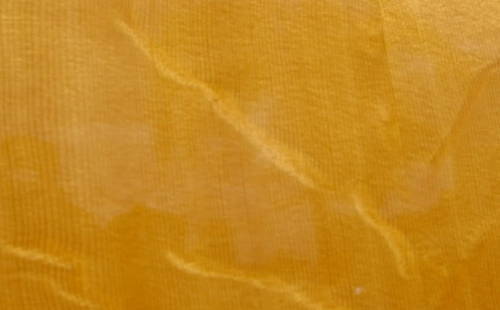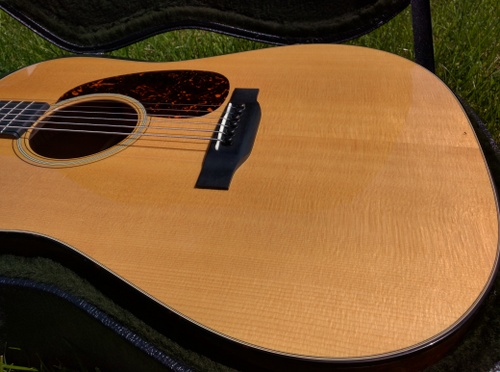This week I’d like to turn our attention to the top of our guitars and talk a little bit about Bear Claw. What is it, why is it there and should you be worried about it?
Bear Claw, also known as Hazelficte, is an asymmetric pattern found on all species of Spruce. It presents itself as fine white lines that will run against the natural grain of the wood. The amount of Bear Claw on a piece of spruce can vary greatly, with some pieces exhibiting a lot while others show little to none.

A close up of Bear Claw on a piece of Sitka
A common misconception about Bear Claw is that bears have anything to do with its formation. The idea goes that if a tree is scratched by a bear, it’s going to leave “scars” after the wood heals . While I will admit that this explanation is a lot cooler than what’s actually happening, it’s simply not true. While it is called Bear Claw because it looks similar to scratch marks, no animals, bear or otherwise, are involved in it’s creation.
Bear Claw is actually just caused by variations in the direction of the wood fibers as a tree grows. When spruce grows it generally has a very straight grain. However, sometimes this straight pattern can be interrupted, causing the grain to become wavy in a small portion of the wood. It’s this waviness and the pattern that it creates that we know as bearclaw.
It’s important to note that Bear Claw is not the same as Silking on a guitar top. While Bear Claw looks like random scratches, Silking is a more uniform wave across a piece of wood. Only found in quarter sawn pieces, Silking gives a guitar a rippling, water like quality. I’m a sucker for a nicely silked piece of Sitka, as you can see on my own D-18 below.

Silking isn't quite the same as Bear Claw
Why are some more ‘Clawed’ than others?
It’s hard to say exactly why some trees develop very heavy Bear Claw while others show little to none. While there is no one definite answer, but there are two commonly attributed causes. The first is simply genetics. Just like how tall people tend to have tall kids, it’s been found that trees with bear claw seem more likely to produce new trees that also have bear claw. Alternatively, bear claw may be caused by environmental stress on the tree during its growth. Things like temperature swings, high winds or varying amounts of rainfall may affect the growth of a spruce tree, causing the grain to vary more and more Bear Claw to develop.
So, why does it matter?
Whether or not Bear Claw affects the tone of a guitar is really the million dollar question and probably the one that most people worry about. Some people have found that heavily Bear Clawed pieces of wood tend to be stiffer and give a brighter sound. The problem is that this increased stiffness may have nothing to do with the Bear Claw at all. Older trees tend to have more Bear Claw but also tend to just be stiffer in general, regardless of the amount of Bear Claw. Personally I have not found that pieces of wood with heavy amounts of Bear Claw sound consistently different than those without and it’s pretty safe to say that when you’re shopping for a guitar you can disregard the effect of Bear Claw on the sound of your instrument.
This means that the only reason to consider Bear Claw when purchasing a guitar is for the looks. Depending on your temperament, the presence or lackthereof of Bear Claw can change how desirable you find it. Some players and collectors really seem to hate Bear Claw, prefering their guitars to have “clean” tops. Others, myself included, appreciate Bear Claw, feeling that it gives the wood some character or personality and it’s not uncommon for custom built guitars with highly Bear Clawed tops to go for hundreds if not thousands more than less clawed pieces.
And that’s about it for this week. Be sure to let us know in the comments below how you feel about Bear Claw. Love it? Hate it? Be sure to tell us why!